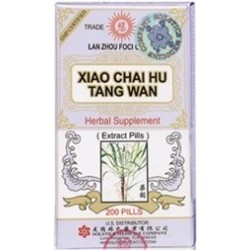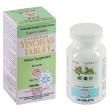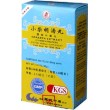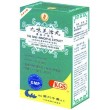Xiao Chai Hu Tang Wan
Expels lingering external pathogen (e.g. cold & flu not yet completely released) to reduce fever, enhance digestive function, strengthen immunity. Use for liver and gallbladder disharmony, conditions symptomized by alternate attacks of chills and fever, chest and upper adominal distension, fatigue, irritability, loss of appetite, nausea, and dizziness.
Ingredients: Bupleurum root, baikal skullcap root, codonopsis root, prepared pinellia rhizome, Chinese licorice root and rhizome, ginger rhizome, jujube fruit.
Directions for Use: Take 8 pills, three times daily.
Contents: 200 pills.
See the NIH's Evidence Based Complementary & Alterntive Medicine Study on Xiao CHai Hu Tang Wan
https://www.ncbi.nlm.nih.gov/pmc/articles/PMC3703324/
Current Understanding on Antihepatocarcinoma Effects of Xiao Chai Hu Tang and Its Constituents
Abstract
Xiao Chai Hu Tang (XCHT), a compound formula originally recorded in an ancient Chinese medical book Shanghanlun, has been used to treat chronic liver diseases for a long period of time in China. Although extensive studies have been demonstrated the efficacy of this formula to treat chronic hepatitis, hepatic fibrosis, and hepatocarcinoma, how it works against these diseases still awaits full understanding. Here, we firstly present an overview arranging from the entire formula to mechanism studies of single herb in XCHT and their active components, from a new perspective of “separation study,” and we tried our best to both detailedly and systematically organize the antihepatocarcinoma effects of it, hoping that the review will facilitate the strive on elucidating how XCHT elicits its antihepatocarcinoma role.
1. Introduction
The American Cancer Society's estimation for primary liver and bile duct cancers in the United States for 2013 is about 30,640 new cases and 21,670 deaths from these cancers. Liver cancer is even more common in sub-Saharan Africa and Southeast Asia and currently is the most common type of cancers in many countries in these regions [1]. Among various types of liver cancer, hepatocellular carcinoma (HCC) is the most common one, and the majority of them are associated with chronic hepatitis B virus (HBV) or hepatitis C virus (HCV) infections [2, 3]. Chronic viral hepatitis, chemical-induced liver damage, could cause liver fibrosis and cirrhosis, finally leading to liver cancer.
Compound herbal formulas have been used to treat cancers, and many of them have shown the promise to improve the life of cancer patients [4–6]. These compound formulas are usually made of several Chinese medicinal herbs and suppress tumor progression by multiple mechanisms [7]. One of them is called Xiao Chai Hu Tang (XCHT, Sho-saiko-to, in Japanese) that was originally recorded in ancient Chinese medical book Shanghanlun. It consists of seven medicinal herbs (Bupleurum falcatum, Scutellaria baicalensis,Panax ginseng, Zizyphus jujube, Pinellia ternate, Zingiber officinale, and Glycyrrhiza glabra) and is currently used to treat chronic liver diseases especially chronic hepatitis [8–11]. Data from recent clinical trials convincingly show that XCHT can prevent the development of HCC in patients with cirrhosis, particularly those without HBs antigen [9]. Experimental studies further indicate that XCHT may achieve its effect by reducing hepatocyte necrosis and enhancing liver function. Moreover, XCHT has also been shown to exhibit various anticarcinogenic properties such as induction of apoptosis and suppression of invasion [12, 13].
Chinese herbal medicines are usually used to counteract tumor progression by a formula of multiple herbs rather than a single one. Unfortunately, studies have been mainly focused on defining the mechanism of a single herb or its ingredients. As each herb in XCHT can potentially exert its effect in a distinct mechanism, a formula of seven herbs is expected to reach its full effect by targeting multipathways and multitargets. So we firstly introduce a new perspective of “separation study,” that is, from the entire formula to single herb and their active components, both detailedly and systematically organize the antihepatocarcinoma effects of XCHT. We hope that this review will help XCHT to receive its well-deserved global recognition and to be better appreciated for its clinical use to treat liver cancers.
2. Xiao Chai Hu Tang (XCHT)
2.1. Clinical Trials of XCHT
XCHT has long been used in clinical trials for the study and treatment of liver diseases. Some XCHT clinical trials (including the clinical trials mentioned above and some other trials [14–17] conducted in China) are summarized in Table 1.
2.2. Experimental Studies of XCHT
The potential tumor-suppressing effect of XCHT was reported in 1994, in which XCHT was found capable of inhibiting the proliferation of KIM-1, a human hepatocellular carcinoma cell line and KMC-1, a cholangiocarcinoma cell line [18]. Later on, XCHT was shown to diminish not only the growth of various cancer cell lines but also in vivo tumor outgrowth in xenograft model [19–21].
In addition to its tumor-suppressing role, Chang et al. studied the effect of XCHT on HBV replication in HepG2 2.2.15 cell model [22]. Their study showed that XCHT reduced HBV production and HBeAg expression without altering the level of HBsAg. Although XCHT can also block Coxsackie B type 1 virus infection in CCFS-1 cells through the induction of Type I interferon expression [23], the mechanism responsible for XCHT-mediated suppression of HBV production awaits being defined.
Hepatic fibrosis and liver cirrhosis result from wound healing of ongoing hepatocellular damage caused by chronic liver injuries [13]. Most of HCCs ensue in a cirrhotic liver [24]. Kusunose et al. created an animal model that reflected various stage-liver injuries and used this model to determine under what condition XCHT extract could improve hepatic inflammation and fibrosis [25]. Their study found that the ability of XCHT extract was limited to a certain degree which was expressed by levels of respective parameters (AST, ALT, TGF-β, hydroxyproline, and the ratio of liver fibrosis area). Chen et al. later elucidated the mechanism pertinent to XCHT's antifibrosis capability by assessing its effect on the expression of those growth factors and cytokines important for the activation of hepatic stellate cells (HSCs) [26]. They showed that XCHT downregulated the levels of stellate cell activation-essential TGFβ1, platelet derived growth factor (PDGF), and IL-1β while stimulated the production of stellate cell activation-inhibitory TNFα.
3. Individual Herbs and Active Components in XCHT
In TCM, XCHT is a classical formula to treat the typhoid lesser yang syndrome. The compound prescription has its formulating principle. Among the seven herbs included in XCHT, Bupleurum falcatum is the “monarch” and Scutellaria baicalensis is the “minister,” which are the principal herbs in this formula. Panax ginseng, Zizyphus jujube, Pinellia ternate, and Zingiber officinale are the “assistant” while Glycyrrhiza glabra is the “guide” [27]. Bupleurum has the effect of upraising and dispersing the pathogen and soothing the meridian Qi. Scutellaria has the effect of clearing and down-sending heat with bitter-cold, as well as eliminating the heat. Panax ginseng and Zizyphus jujube work compatibly to tonify Qi and fortify the spleen, thus strengthening the body and eliminate pathogens; Pinellia ternate and Zingiber officinale work together to regulate the stomach Qi and prevent vomit; and the “guide” Glycyrrhiza glabrais used to harmonize the other herbs. Nowadays, XCHT is used to treat common cold, chronic hepatitis, hepatic cirrhosis, bile reflux gastritis, cholecystitis, acute pancreatitis, and so forth, which belong to lesser yang syndrome.
3.1. Bupleurum falcatum
The root of Bupleurum falcatum L. (Umbelliferae), especially B. chinense from mainland China and B. falcatum from Japan [28, 29], is also called Bupleuri Radix ((BR) Chaihu, in Chinese and Saiko in Japanese) and is one of the principal herbs in XCHT. Early study examined the hepatoprotective effect of several BR extracts with dimethylnitrosamine- (DMN-) induced hepatic fibrosis rat model and these extracts appeared to prevent fibrosis by improving liver function and modulating the levels of relevant cytokines [29]. Recent studies also suggest BR extracts as potent antioxidant agents because they are able to decrease L-thyroxine-induced hypothyroidism and to enhance the liver antioxidant defense systems [30].
Some saikosaponins, which are the active ingredients of BR, have been found to suppress hepatic fibrosis [31, 32], hepatocarcinoma [33–36], and HBV infection [37] and improve chemotherapy [38]. The different mechanisms through which saikosaponins suppressed hepatocarcinoma were summarized in Figure 1. Saikosaponin a (SSa) was shown to effectively inhibit CCl4-induced liver inflammation and fibrosis in SD rats by simultaneously blocking the production of hepatic proinflammatory cytokines/growth factors (TGFβ1 and hydroxyproline) and increasing the expression of anti-inflammatory cytokine IL-10 [31]. Saikosaponin d (SSd) was found to suppress hepatic fibrosis through the downregulation of TNF-α, IL-6, and NF-κB activities [32]. SSa may inhibit HepG2 growth by increasing the levels of p-15INK4a and p-16INK4b (cyclin-dependent kinase inhibitors) in a protein kinase C (PKC) [33] and/or extracellular signal-regulated kinase (ERK) signaling pathway-dependent manner [34]. SSd markedly reduced the liver nodule, tumor cell invasion while increased cellular atypia in xenograft model [35]. It appeared that SSd exerted its action by diminishing the expression of highly expressed cyclooxygenase 2 (COX-2) and CCAAT/enhancer-binding protein β (C/EBPβ) in tumor cells and macrophages of liver tumors [35]. In a study reported by Zhu et al. [36], SSd was shown capable of reversing the malignant phenotype of HepG2 cells. SSd-treated HepG2 cells grew and migrated at slower rate, had decreased volume ratios of nucleus to plasma and small round cell shape. At molecular level, SSd decreased the level of alpha-fetoprotein (AFP) and enhanced the expression of cell cycle inhibitor p27. Moreover, Chiang et al. showed that HBV-containing human hepatoma cells (2.2.15 cells) treated with saikosaponin c (SSc) secreted significantly less HBeAg into culture medium and had reduced HBV DNA replication [37]. Although not directly using liver cancer cells, SSa and SSd were also shown to sensitize cervical (HeLa and Siha), ovarian (SKOV3), and lung cancer cells (A549) to cisplatin-induced cell death by inducing the production of reactive oxygen species (ROS) and activation of caspases [38].
3.2. Scutellaria baicalensis
The dry root of Scutellaria baicalensis, Scutellaria radix ((SR) Hangqin, in Chinese ) is another principal herb in XCHT. Accumulating evidences indicate that wogonin, baicalein, and baicalin are the principal active components in SR [39]. SR has been widely used to treat hyperlipemia, atherosclerosis, and hypertension. Recent studies with various model systems suggest that SR also possesses a potent cytostatic [40–42], anti-inflammatory [43] and antiviral capabilities [44, 45].
Antitumorigenesis ability of SR was reported by Gao et al. in human lung cancer cells (SK-MES-1, SK-LU-1, and A549) [42]. Their study showed that the absolute ethanol extracts of Scutellaria baicalensis, baicalin, baicalein, and wogonin all displayed a concentration- and time-dependent cytotoxicity to lung cancer cells while were only weakly cytotoxic to the normal human lung fibroblasts. Jung et al. later discovered that Scutellaria baicalensis is an anti-inflammatory agent because it decreases histamine release and inhibits the passive cutaneous anaphylaxis reaction in SD rats [43]. Antiviral effect of Scutellaria baicalensis was shown by Tang et al., in which it was shown to significantly inhibit the replication of HCV RNA in HCV-infected nude mice [44]. Later study revealed that the aqueous extract of Scutellaria baicalensis was also able to suppress the replication of lamivudine-resistant HBV mutant in human hepatoma cells by suppressing HBV core promoter activity [45].
Besides the studies performed with Scutellaria baicalensis, active components of it have also been extensively investigated (Figure 2). TNF-related apoptosis-inducing ligand (TRAIL) has been recognized as a promising anticancer agent because it kills tumor cells without damaging normal tissues [46, 47]. However, resistance to TRAIL is frequently seen in various tumor types. Ding et al. found that wogonin and structurally related natural flavones apigenin and chrysin overcame TRAIL resistance by downregulating the level of c-FLIP (a key inhibitor of death receptor signaling) and up-regulating TRAIL receptor 2 (TRAIL-R2) expression in human T-cell leukemia virus type 1- (HTLV-1-) associated adult T leukemia/lymphoma (ATL) cells [48]. They further showed that these flavones could enhance TRAIL-mediated apoptosis in a wide variety of cancer cell types including hepatocellular carcinomas (HepG2), breast (MDA-MB-231), colon (HT-29), and pancreatic cancer cells (Capan-1) as well as melanoma cells (SK-MEL-37) [48], implicating the use of flavones as an adjuvant for TRAIL-mediated anticancer therapy. In another study, Polier et al. initially showed that wogonin and flavones are inhibitors of cyclin-dependent kinase 9 (CDK9) and can effectively block phosphorylation of the carboxy-terminal domain of RNA polymerase II at Ser2, which in turn reduces RNA synthesis and subsequent downregulation of antiapoptotic protein myeloid cell leukemia 1 (Mcl-1), leading to significant apoptosis in a variety of human cancer cells [49]. However, wogonin-induced apoptosis of human hepatocarcinoma cells was found to be accompanied with Bax increase and Bc1-2 decrease [50, 51]. Anti-HBV effect of wogonin was also found in vitro and in vivo [52], with the HBV antigen and HBV DNA level reduction.
Baicalein, a flavonoid extracted from SR, has been shown to possess potent antitumorigenesis capability toward liver cancer cells. For example, baicalein is highly cytotoxic to HCC cell lines and exerts its cytotoxicity by reducing mitochondrial transmembrane potential and subsequent cytochrome c release and caspase-3/9 activation. Disruption of MEK-ERK signaling pathway is at least partially responsible for baicalein-induced cytotoxicity [53, 54]. When used in vivo, baicalein can significantly inhibit tumor growth of HCC xenografts [53]. In another study, baicalein was reported to block cell migration and invasion of human hepatoma cells through multiple mechanisms including the suppression of MMP-2, MMP-9, and uPA expressions, blockage of NF-κB activation, and decreasing the phosphorylation levels of PKCα and p38 MAPK activities [55]. In a recent study, Sun et al. showed that baicalein dose dependently decreased AST, ALT, hyaluronic acid, laminin, and procollagen type III (PCIII) in serum as well as hydroxyproline and MMPs in liver in CCl4-induced liver fibrosis model [56]. Moreover, baicalein also alleviated inflammation, destruction of liver architecture, collagen accumulation and expression of PDGFβ receptor, thus preventing the activation of stellate cells and liver fibrosis [56].
Baicalin is also an important active component included in SR. Zhang et al. [57] found that baicalin induced apoptosis with downregulation of glycosylated immunoglobulin superfamily transmembrane protein CD147 expression in SMMC-7721 cells, and interestingly, this effect was accompanied with cell autophagy. This study firstly suggested that baicalin induced autophagy cell death in SMMC-7721 cells and revealed a new mechanism for the anticancer effects of baicalin. Qiao et al. [58] studied the antihepatic fibrosis effect of baicalin and found that transplantation with baicalin-treated mesenchymal stem cells in combination with baicalin administration had the best therapeutic effect for hepatic fibrosis. This may further introduce a new therapeutic regimen for some liver diseases. Baicalin combined with oxymatrine showed better effect against HBV replication than oxymatrine in vitro, which was proved by Cheng et al. [59]. In aspects of the potential protective effect on liver injury, baicalin was also researched in many experiments [60–62]. Activation of peroxisome proliferator-activated receptor (PPARγ) signaling pathway, and Toll-like receptor 4- (TLR4-) mediated inflammatory responses were involved in the protective effect.
3.3. Panax ginseng
Ginseng products are regularly consumed worldwide for the purpose of increasing vitality [63]. Recently, many studies have shown the chemopreventive or adjuvant effect of it [64]. A study involving two cases of control (905 pairs and 1987 pairs, resp.) and a cohort (4675 subjects) demonstrated the benefit of ginseng use for cancer prevention as ginseng use was found to be nonorgan-specific cancer preventive, and its effect depends on the frequency of ginseng intake [65].
In addition to ginseng's preventive effect toward cancer, evidences from experimental studies also suggest its direct role to suppress liver tumorigenesis. Wu et al. showed that ginseng lowered the rate of hepatoma development and prolonged life span on diethylnitrosamine (DEN) rat liver cancer model [66]. Kwon et al. found that oral administration of ginseng decreased&
- Brand: Lanzhou, China
- In Stock
-
$10.00
Related Products
Yinchiao Tablet
The sweet original! Excellent when taken immediately or upon the first or second day of wind-heat flu symptoms that include swollen lymph nodes, sore throat, body ache, fever with chills, headache, so..
$15.00
Heparex Extract or Xiao Chai Hu Tang Wan
Use to bolster immune system, to ward off colds, for liver-related and breast disorders. Has been proven effective in inhibiting bacteria, viruses and leptospira, making the body more resistant to cer..
$6.00
The Nine Immortal Extract, Jiu Wei Qiang Huo Wan
Dispels damp to clear internal heat due to wind invasion, cold/damp conditions with fever, chills, inability to sweat, headache, rigid neck, aching limbs, bitter taste, white/yellow coated tongue. A t..
$6.00






